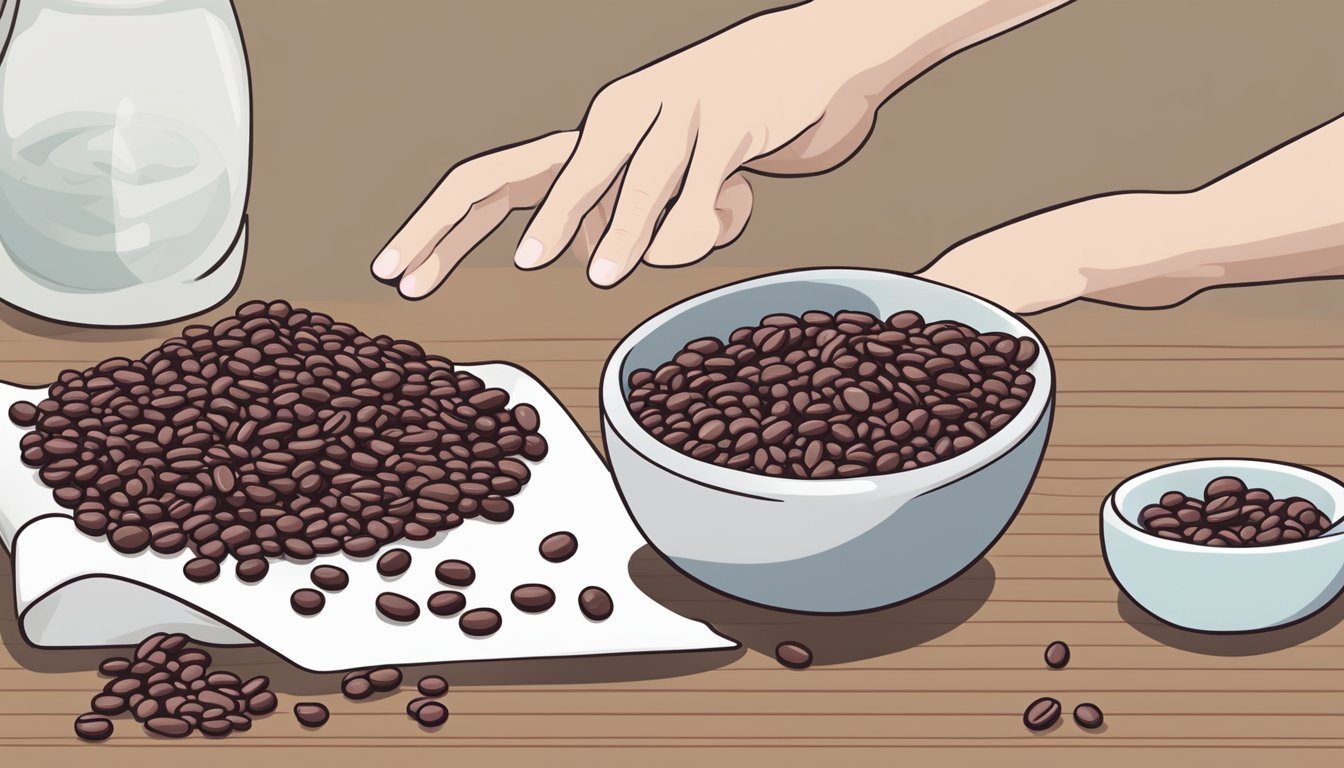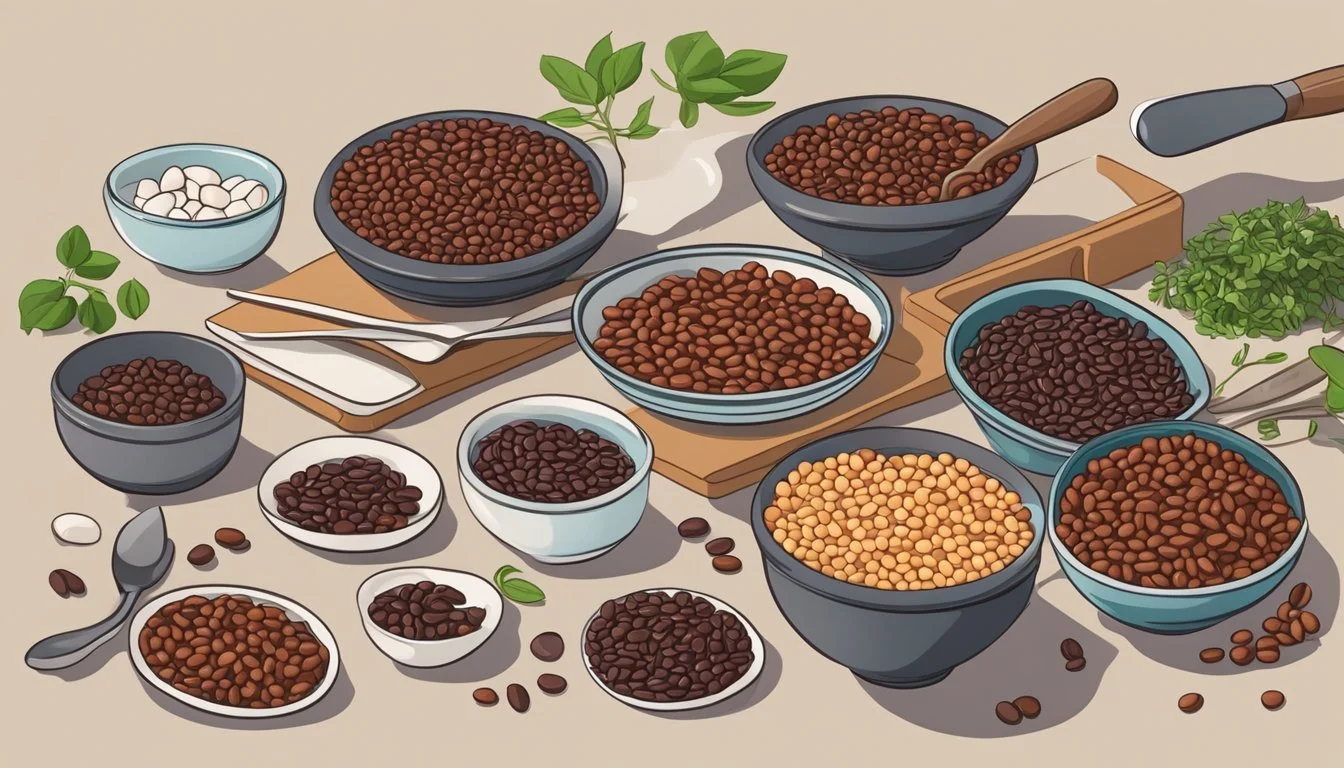How to Substitute Adzuki Beans for Red Beans
A Simple Guide
Adzuki beans and red beans, both integral components of various cuisines across the globe, often create a point of culinary confusion. Due to their similar size and color, they are commonly considered interchangeable in recipes. However, discerning chefs recognize the nuanced differences in flavor and texture between the two. Adzuki beans, with their inherently sweet taste, are a staple in Asian desserts, while red beans, particularly red kidney beans, boast a more robust flavor profile, making them a favorite in savory dishes.
When substituting adzuki beans for red beans, it's important to consider the desired outcome of the dish. Adzuki beans' sweetness might not be suitable for all recipes calling for red beans. Adjustments to the seasoning might be necessary to achieve a comparable taste. Additionally, the cook time for adzuki beans is typically shorter than that for red kidney beans, which means that adzuki beans can become tender more quickly during the cooking process.
For those looking to match the deep red color of red beans in their recipes, choosing kidney beans as a substitute can be an effective solution. Though red beans and adzuki beans are not identical, managing their differences adeptly can result in a satisfying culinary creation that maintains the integrity of the original dish. When swapping these beans, home cooks and professional chefs alike should do so with a mindful awareness of the variations in flavor and texture.
Understanding Bean Varieties
When considering the varied landscape of legumes, particularly beans, it is crucial to recognize the distinct characteristics and culinary uses of each variety. Among the extensive family of beans, adzuki beans are often sought for their sweet flavor and firm texture, yet many cooks may find themselves in need of a substitution. In such cases, other bean varieties can offer similar qualities.
Kidney beans and small red beans closely mimic the size and shape of adzuki beans, and they provide a full-bodied flavor suitable for robust dishes. Mung beans, especially the yellow and green varieties, cook down to a smooth consistency, making them a good alternative in pastes and desserts traditionally made with adzuki beans.
For soups and stews, the black beans and black turtle beans contribute a strong flavor and hearty texture. Pinto beans, with their earthy notes, stand out in chilis and Mexican cuisine. Cannellini beans and navy beans offer a delicate and creamy consistency, performing well in purées or as a base for spreads.
For a meaty texture, cooks might turn to fava beans or butter beans (also known as lima beans), which are larger and can impart a rich presence in salads or as a side dish. Cranberry beans and borlotti beans are also notable for their creamy texture and striking appearance.
Bean Variety Typical Use Texture Flavor Notes Kidney Beans Chilis, Soups Firm Rich, Full Mung Beans Pastes, Desserts Smooth Subtly Sweet Black Beans Soups, Salads Hearty Earthy Cannellini Beans Purées, Spreads Creamy Nutty Lima Beans Side Dishes, Salads Meaty Buttery
While great northern beans share a mild flavor and firmness favorable for casseroles, chickpeas (or garbanzo beans) stand out in Mediterranean and Middle Eastern dishes due to their unique texture and taste. Lentils, with their quick-cooking nature, are versatile in soups and salads, whereas black-eyed peas are a staple in the Southern United States cuisines.
Each bean variety has a distinct profile and optimal culinary application, making them suitable substitutes depending on the desired outcome of the dish. The third person seeking to replace adzuki beans should consider the intended flavor and structural integrity of the recipe to select the most complementary variety.
Nutritional Profile of Adzuki Beans
Adzuki beans are a nutrient-dense legume offering a rich source of protein and fiber, as well as a variety of essential minerals that contribute to overall health.
Comparing Protein and Fiber Content
Adzuki beans are an excellent source of protein, with a typical serving containing about 17 grams of protein, which is about 34% of the daily value. They contribute significantly to the maintenance and repair of tissues in the body.
In terms of fiber, Adzuki beans provide around 16 grams per cooked cup, equating to approximately 63% of the recommended daily intake. Fiber is crucial for digestive health and helps in regulating blood sugar levels.
Minerals in Adzuki Beans
Iron and magnesium are notable minerals found in Adzuki beans. Here's a breakdown:
Iron: A single serving can supply approximately 2.6 mg of iron, translating to about 14% of the daily value. Iron is essential for the production of hemoglobin and overall energy levels.
Magnesium: With around 120 mg in a serving, Adzuki beans offer about 30% of the daily recommended intake of magnesium, which plays a role in over 300 enzyme reactions in the human body.
These beans also contain other critical nutrients, such as potassium, zinc, and vitamins, which collectively support cardiovascular health and may reduce the risk of chronic diseases. Notably, the antioxidants found in Adzuki beans help in protecting against oxidative stress.
Culinary Uses of Adzuki Beans
Adzuki beans, prized for their versatility, are a staple ingredient particularly in Asian cuisine, providing distinctive flavors and textures to a variety of sweet and savory dishes.
Adzuki Beans in Asian Recipes
In many Asian recipes, adzuki beans serve as the foundation for anko, a sweet red bean paste. This paste is a common filling in Japanese sweets such as dorayaki (a type of pancake), taiyaki (fish-shaped cake), and daifuku (glutinous rice cakes). The texture of adzuki beans is critical, as it must be smooth after cooking and have a naturally sweet taste, which complements these iconic Asian desserts. The process of making anko involves simmering the beans until they are soft, which are then mashed or pureed and sweetened.
Sweet and Savory Dishes
Adzuki beans lend themselves effectively to both sweet and savory dishes. In sweet applications, apart from anko, they can be mashed with sugar to create a sweet paste used in various desserts, often as a filling or topping. Meanwhile, in savory dishes, adzuki beans are used similarly to other legumes in stews and soups, providing a rich, nutty flavor and a hearty texture. Despite their association with sweet flavors, they also complement savory ingredients, as seen in some Chinese and Korean dishes. When incorporating adzuki beans in place of red bean paste or chestnut paste, one should consider the nuanced taste differences and texture to maintain the integrity of the dish, be it a Japanese confection or a hearty Asian stew.
Substitution Basics
When replacing adzuki beans with red beans, one must carefully consider the flavor and texture to ensure culinary success.
Flavor and Texture Considerations
Flavor: Adzuki beans have a mild, sweet, and slightly nutty flavor that is appreciably different from the earthy flavor of red beans. When substituting red beans, it is essential to recognize this taste variance and adjust other ingredients like sugar accordingly.
Texture: Red beans tend to have a firmer texture after cooking, whereas adzuki beans usually present a creamier texture. This quality makes adzuki beans ideal for dishes that require a softer bean consistency.
Creamy Dishes: For dishes that call for a creamy consistency, such as bean paste or soups, adzuki beans are an excellent substitute for red beans.
Firmer Dishes: In meals that benefit from beans that hold their shape, slightly undercooking the adzuki beans can closer mimic the desired texture.
Color and Appearance Factors
Adzuki beans are generally smaller and have a distinctive dark red color, which can differ from the deeper hues of some red beans. For visual appeal in dishes:
Salads and Side Dishes: The red color of adzuki beans can enhance the visual aspect of dishes where the appearance of individual beans is prominent.
Purees and Pastes: In recipes that require blending, such as spreads, differences in color between red beans and adzuki beans are less noticeable and thus less of a concern.
It is important to consider these characteristics to maintain the integrity of the final dish when substituting adzuki beans for red beans.
Best Substitutes for Adzuki Beans
When looking to substitute Adzuki beans, the goal is to mimic their texture and flavor profile while also considering the dish's needs. These legumes are versatile; however, certain substitutes work best in specific types of dishes.
Red Kidney and Pinto Beans for Hearty Meals
Red Kidney Beans: These are a robust option that holds their shape well, making them ideal for stews and chili. Their flavor is stronger than Adzuki beans, yet they can be mashed for a similar consistency.
Best Uses: Chili, red beans and rice, hearty stews
Texture & Flavor: Firm texture, strong flavor
Pinto Beans: With a creamy texture and a nutty flavor, Pinto beans are a good substitute in recipes where mashed Adzuki beans would be used.
Best Uses: Mashed preparations, refried beans, soups
Texture & Flavor: Soft and creamy, mild and earthy
Mung and Black Beans in Lighter Preparations
Mung Beans: For lighter dishes that require a bean with a subtle flavor and a texture that doesn't overwhelm, Mung beans are an excellent choice.
Best Uses: Soups, salads, pastes
Texture & Flavor: Delicate and slightly sweet
Black Beans: The high protein Black beans have a meaty texture and are a strong contender for replacing Adzuki beans in dishes where a bolder flavor profile is desired.
Best Uses: Soups, salads, and various Latin American cuisines
Texture & Flavor: Dense and meaty, with a pronounced earthiness
These substitutes not only fit different cooking methods and dishes but also maintain the nutritional integrity often sought after in Adzuki beans.
Alternative Beans in Specific Dishes
Adzuki beans are versatile in a diverse range of dishes, from savory stews to sweet desserts. When substituting adzuki beans with red beans, it's important to adjust recipes according to the texture and flavor profile of the red beans to maintain the integrity of the dish.
Substitutes in Soups and Stews
Soups and stews benefit from red beans' firmness and ability to absorb flavors. In East Asia, adzuki beans are often used in red bean soup, a sweet dessert. Red beans can be substituted while carefully balancing sugar levels to match the natural sweetness of adzuki beans. For savory soups and stews, including Chinese dishes, red kidney beans provide a similar texture and a robust flavor. Use them in equal proportions to adzuki beans.
Beans for Rice and Pasta Dishes
Red beans are a steadfast choice for hearty rice and pasta dishes. Red beans and rice, a classic vegetarian or vegan dish, retains its character when red beans are used in place of adzuki beans. One can also use them in chili, as they hold their shape well and contribute to a thick, satisfying texture. In rice dishes, particularly those from East Asia, red mung beans offer a closer textural similarity to adzuki beans and can be used interchangeably.
Alternatives for Sweet Recipes
When dealing with sweet recipes, such as fillings for pastries, red beans require additional sweetening to mimic the adzuki beans' natural sweetness. A paste of red beans, enhanced with sugar, can replace sweet fillings traditionally made with adzuki beans. It is essential to achieve a smooth consistency in the paste for authentic sweet recipes. Cook the red beans until they are very soft, then blend with a sweetener to create a spreadable paste.
Cooking Techniques for Bean Substitutes
When substituting adzuki beans for red beans, one must consider the cooking techniques to achieve a similar flavor and texture profile. These techniques ensure the substitutes integrate seamlessly into your recipes.
Boiling and Mashing Methods
Red beans typically need a longer boiling time than adzuki beans due to their denser structure. When substituting red beans, they should be boiled until tender, which could take approximately 1 to 1.5 hours. After boiling, red beans can be mashed to a similar consistency as adzuki beans. This is particularly important when creating pastes or fillings where adzuki beans would normally provide a smoother, creamier texture.
Start with cold water to cover the beans by several inches, bringing them to a boil.
Reduce to a low simmer and cook until the beans are soft.
For a creamier texture, add a small amount of the cooking liquid back into the mashed beans.
Incorporating Spices and Seasonings
The spices and seasonings used in a dish can significantly affect its overall flavor profile. When substituting adzuki beans with red beans, the latter's stronger taste should be balanced with the appropriate spices. Onions and garlic are versatile options that complement the robust flavor of red beans. They should be sautéed until translucent before being combined with the beans.
For dishes like refried beans, starting with a base of well-seasoned onions and garlic can help red beans mimic the sweet, nutty notes of adzuki beans.
Seasoning Mixture: Combine ground cumin, coriander, and paprika for a balanced spice mix.
1 tsp cumin
1 tsp coriander
1/2 tsp paprika
Add the spice mix early in the cooking process to allow the flavors to infuse with the beans.
Cultural Significance and Regional Preferences
Adzuki beans carry a significant cultural weight in East Asia, where they are a staple in many traditional dishes. In Japan, adzuki beans are often used in sweet treats like anko (red bean paste) used in desserts such as taiyaki and daifuku. The red color of the beans is considered lucky and signifies happiness and celebration, making them a key ingredient in dishes like sekihan—red bean rice traditionally served at festive occasions.
In China, adzuki beans are similarly utilized in sweetened red bean paste, a common filling for mooncakes and steamed buns. Their cultural importance extends beyond cuisine; the beans are also used in Traditional Chinese Medicine for their supposed health benefits.
Nepal sees adzuki beans often paired with rice or used in soups, highlighting their versatility in savory applications as well.
Below is a brief overview of how adzuki beans are featured in different regions:
Region Common Use of Adzuki Beans Notes Japan Desserts, Sweet Pastes, Festive Dishes Associated with luck and celebration. China Sweet Pastes, Medicine Integral to traditional medicine and desserts. Nepal Soups, Rice Accompaniments Used in both sweet and savory contexts.
The regional preferences for adzuki beans are shaped by these cultural contexts, making them more than just a food item, but part of the culinary identity in these areas. Substituting red beans for adzuki should take into account not only the similar characteristics they share, such as size and flavor, but also the cultural expectations and traditional uses of adzuki beans in each region.







